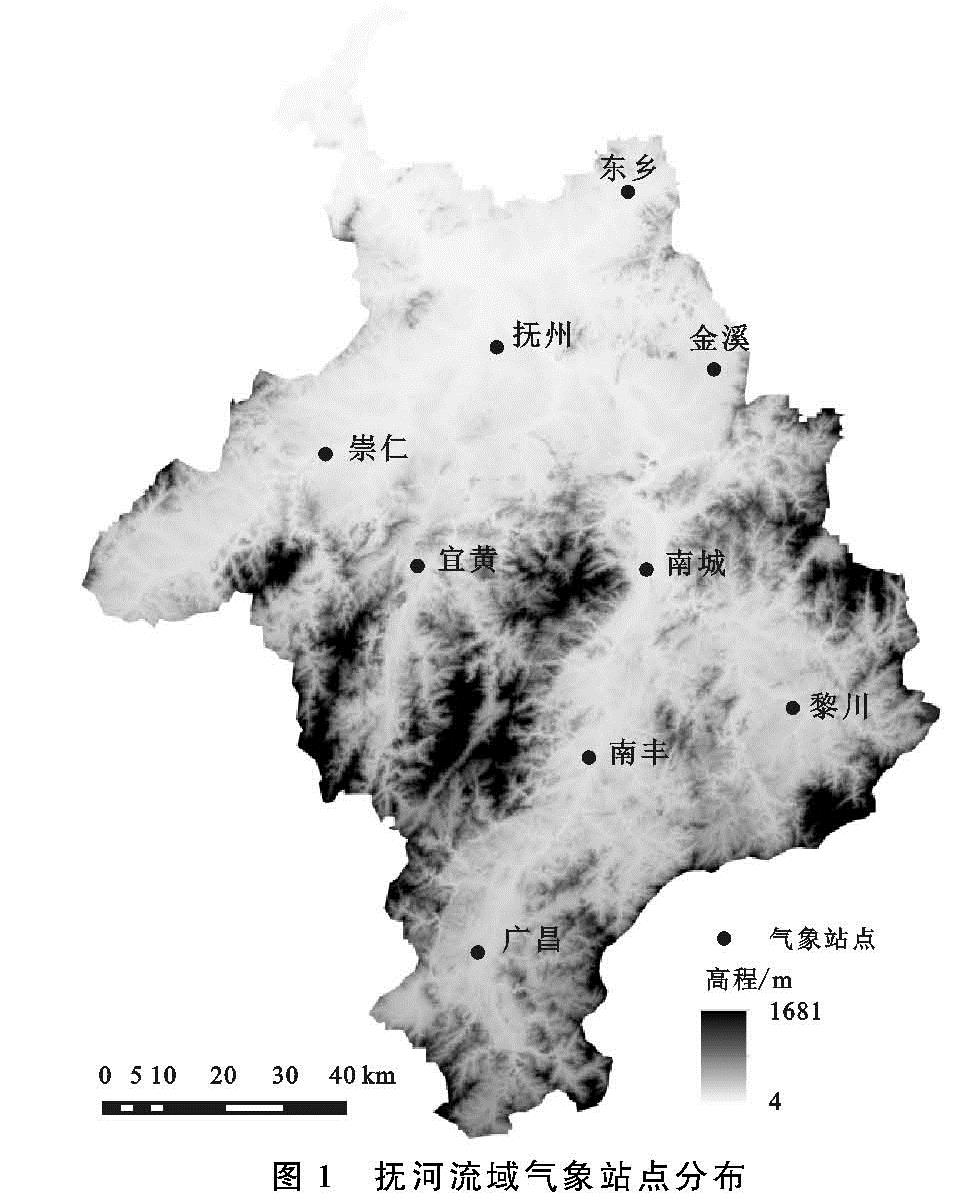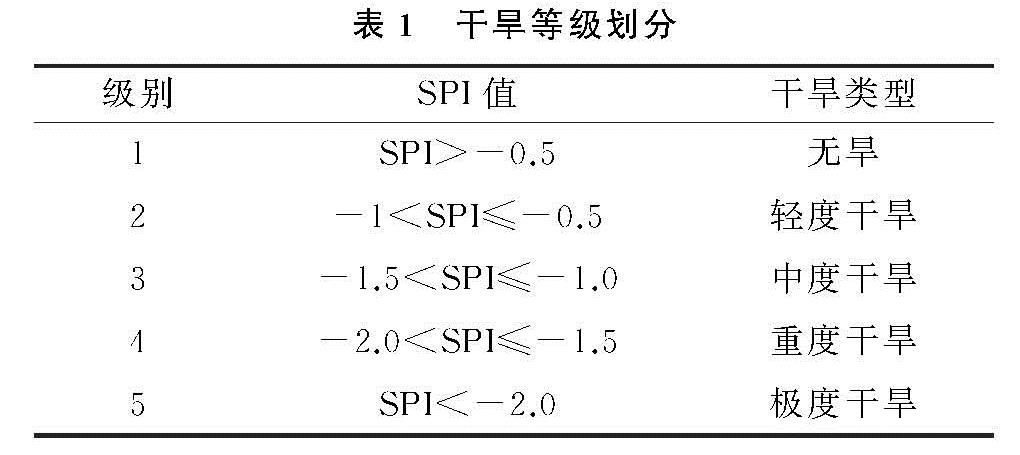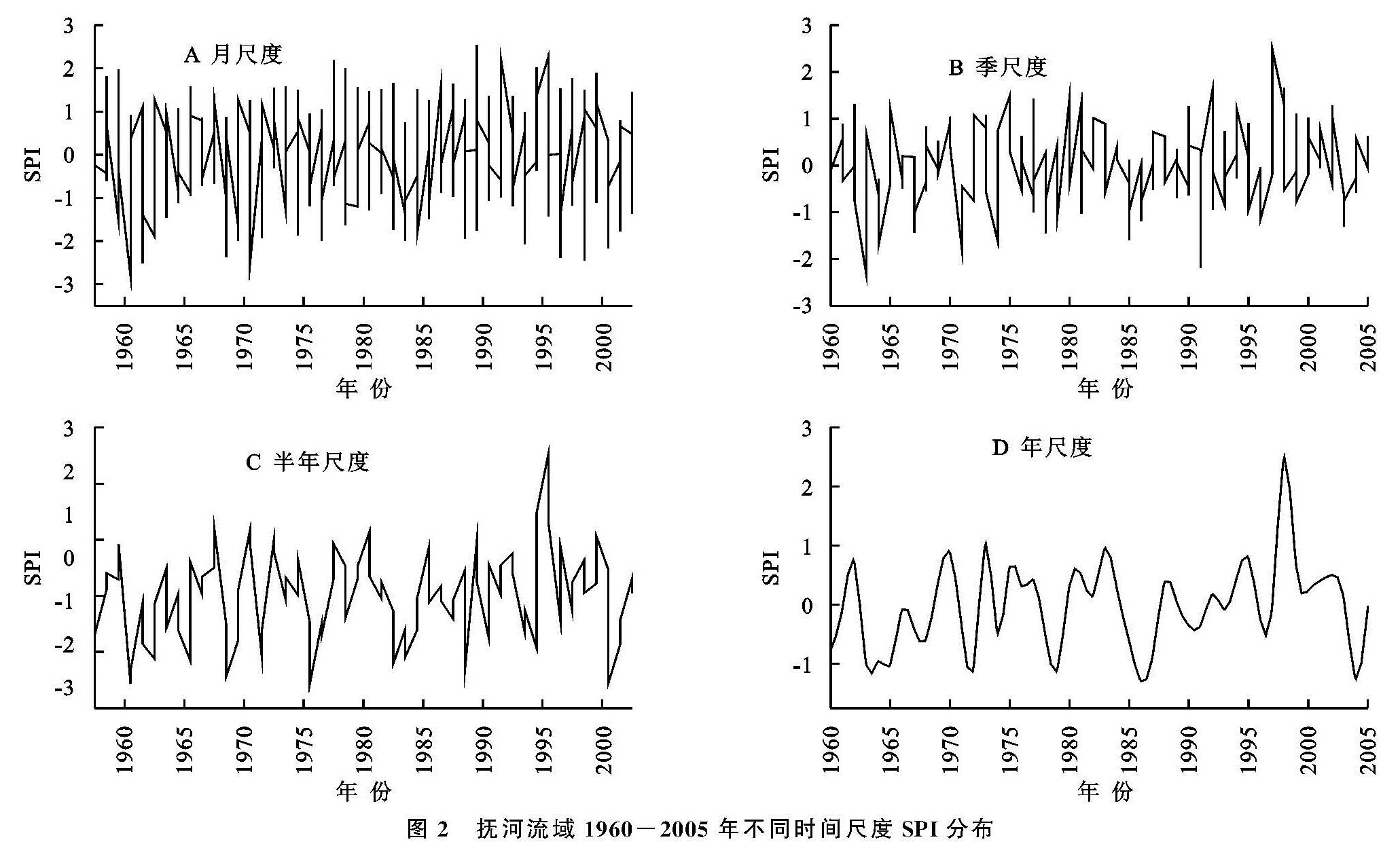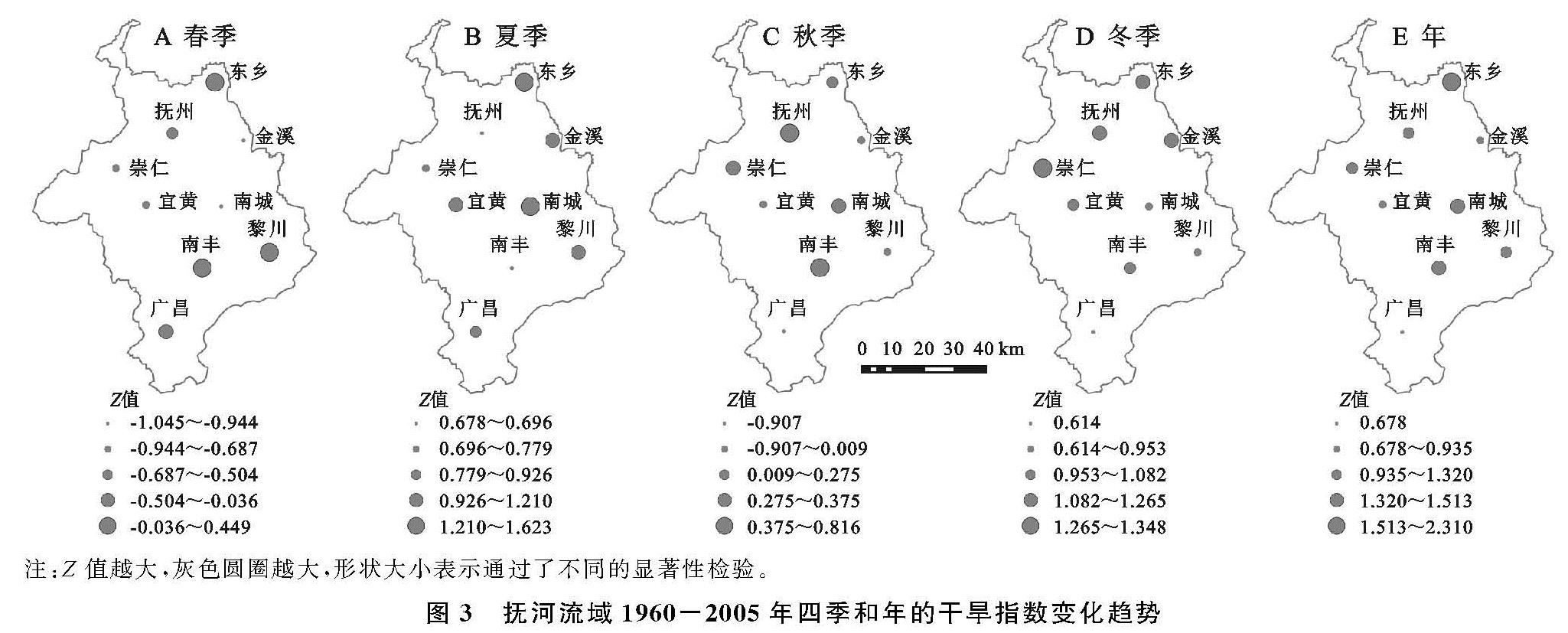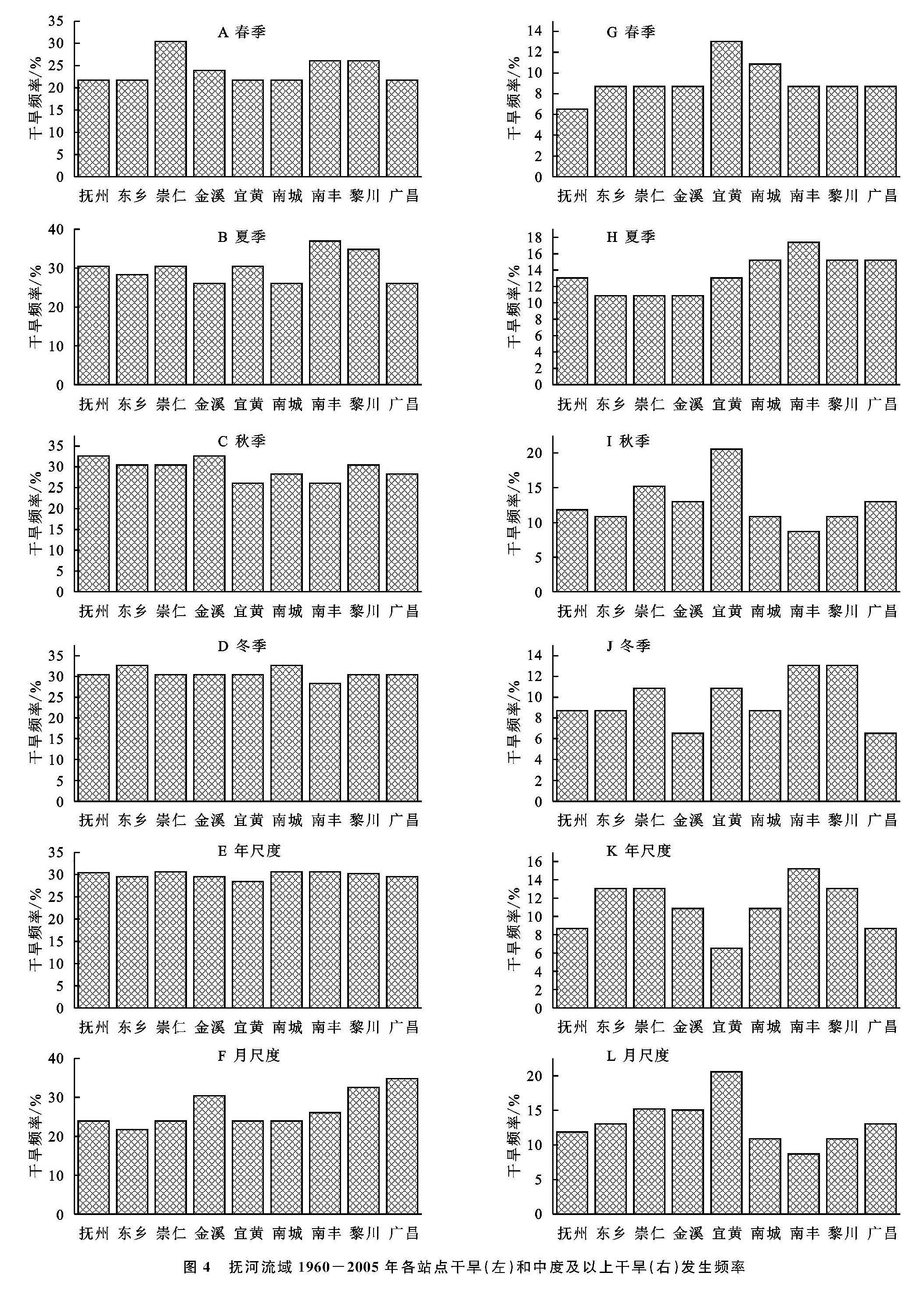3.3.1 干旱频率分布
季尺度上,春旱主要分布在抚河流域西北和东南地区(图4A),干旱频率最大值出现在崇仁,达30.4%以上。夏季干旱发生频率更高,各地区之间相差较大(图4B),干旱频率发生最大值为南丰与黎川,分别为37.0%,34.8%,金溪、南城和广昌发生频率最低,均为26.09%,其他地区为28.26%~30.43%。秋季干旱主要发生在抚河流域东北部(图4C),生频率最大为抚州和金溪,均为32.61%。冬旱(图4D)发生频率约为30.67%,发生频率最大和最小,东乡和南丰,分别为32.61%,28.26%。
从图4E可以看出,年尺度干旱(SPI12)发生频率为29.95%,地区的差异较小,发生频率最小的为宜黄,频率为28.44%,最大为南丰、南城和崇仁,发生频率为30.61%,上述地区以外基本都在30%; 月尺度干旱发生频率最大的为广昌,频率为34.79%,东乡为所有地区频率最小,为21.74%,其他地区为23.91%~32.61%(图4F)。
3.3.2 抚河流域中旱及以上干旱频率分布
春季中旱及其以上干旱发生频率最低的为抚州,仅6.52%,发生频率最高的为宜黄,达13.04%,其他地区干旱频率稳定在8.70%~10.87%,各地区差异显著(图4G)。夏季中旱以及以上干旱各地区差异相比春季小,发生频率最大的地区为南丰,达17.39%,夏季平均发生频率为13.53%,金溪、崇仁和东乡发生频率最小,为10.87%,主要集中在抚河流域东北部(图4H)。秋季中度及以上干旱发生频率最高的为宜黄,达19.57%,最低为南丰,发生频率仅为8.70%。其他地区发生频率为10.87%~15.22%(图4I)。冬季中旱以上发生频率最高的地区为南丰和黎川,为13.04%,最低为金溪和广昌,为6.52%。地区差异明显(图4J)。
年尺度上,中度及以上干旱发生频率最高值为15.22%,发生在南丰,最小发生在宜黄,发生频率为6.52%,其他地区稳定在8.70%~13.04%,地区差异明显(图4K); 月尺度上,发生中度及以上干频率最大和最小的地区为宜黄和南丰,分别为19.60%,8.60%,月尺度下的平均发生频率为11.92%,地区差异较大(图4L)。
3.4 ENSO对抚河流域干旱的影响
北太平洋海温和大气环流变化异常对气候有着重要的作用,赵永平等[18]发现ENSO通过影响东亚季风环流和太平洋副热带高压,对东亚和中国从沿海到内陆地区都产生了影响。许多研究表明海表温度指数和干湿变化关系最大,因此分析SSTA和SPI的相关性、ENSO事件和对抚河流域干旱的对应关系,具有现实意义。
图4 抚河流域1960-2005年各站点干旱(左)和中度及以上干旱(右)发生频率
3.4.1 SSTA与SPI值的相关性分析
通过选用相同时间尺度的SSTA指数和抚河流域各站点四季SPI值进行皮尔森相关系数分析,由图5可以看出,抚河流域春季SPI与SSTA指数之间均呈正相关关系(图5A),其中东乡、广昌正相关关系显著(p<0.05),相关系数分别为0.303,0.361,除上述地区外,研究区内其他站点均未通过显著性水平检验,流域内东南部的春季SPI与SSTA指数之间相关性显著。抚河流域夏季SPI与SSTA指数除南丰和广昌呈正相关外,其他地区均呈负相关关系,且整体相关性小,所有站点均为通过显著性水平检验(图5B)。秋季(图5C)以东乡—抚州—宜黄—广昌为分界线,分成东西两部分,分界线以东相关性均大于以西地区,所有地区均呈现正相关关系,但相关性水平不高,均未通过显著性水平检验,相关系数最高的两个地区为金溪、黎川,分别为0.249,0.231。冬季SPI与SSTA指数之间整体呈正相关(图5D),显著性水平整体较低,最高地区为宜黄,相关系数为0.135。同夏、秋季一样,冬季所有地区也均未通过显著性水平检验,四季平均相关系数为0.259,-0.066,0.186,0.095,总体而言,抚河流域春季SPI与SSTA指数相关性最为显著,秋季次之,夏季的相关性最弱。
3.4.2 ENSO冷暖事件
由于ENSO事件通对中国境内的气候产生不同程度的影响,因此,对1960—2005年ENSO暖冷事件对抚河流域月尺度SPI值进行统计[19](表2),ENSO冷暖事件对应月份来源于NOAA-ESRL提供的相关资料,SPI值为历年月份的每月均值。研究表明:在ENSO暖、冷事件发生时,对应SPI的月均值为0.177,-0.161; 冷暖事件发生时,SPI月均值为-0.008,ENSO非冷暖事件时,SPI月均值为0.080。由于SPI数值越大,越“湿润”,反之“干旱”[20]。ENSO冷暖事件时,SPI月均值小于非ENSO冷暖事件时的SPI月均值,说明ENSO冷暖事件变化对抚河流域干旱有一定影响。
表2 1960-2005年ENSO冷暖事件及对应抚河流域标准化降水指数(SPI)
3.4.3 ENSO事件强度与SPI影响因子关系分析
李小燕等将ENSO暖冷事件强度的等级主要划分为极强和强、中等、弱和极弱3个等级,其中未受ENSO事件影响年份的强度用0表示[21],ENSO暖冷事件强度分别用3,2,1和-3,-2,-1表示[22]。据此对1960—2005年来ENSO发生强度进行统计,将抚河流域1960—2005年降水量距平和ENSO发生强度进行6次多项式拟合,得到了两者的变化趋势[23](图7),从图中可以看出,ENSO事件对抚河流域降水的影响较大,在1960—2005年期间,随着ENSO事件强度的变化,降水量也随之变化,大体有相同的趋势变化。ENSO暖事件年份发生干旱的可能性大于冷事件年份。
3.4.4 ENSO事件强度与抚河流域SPI的关系分析
由图7B可得,整个研究时期内抚河流域年SPI值得线性变化趋势不明显,从SPI值5项多项式拟合看出,在1960—1980年,抚河流域发生了4次中旱与轻旱,干旱事件发生频率较大,在20世纪80年代以后,发生了2次中旱与轻旱,频率较之前减小。总体来说,1960—2005年抚河流域SPI数值加大,干旱灾害发生的频率逐渐降低。
结合表2和图7B,抚河流域年SPI值和ENSO事件强度的相关分析得出,两者之间呈显著负相关关系(Pearson相关系数为-0.083,α=0.05)。在发生ENSO暖事件时,SPI值相对较大,而在ENSO冷事件时,SPI值相对较小,在1960—2005年里,抚河流域的干旱事件主要发生在ENSO事件年的当年、上(下)一年,在发生的6个轻旱以上事件年份里均发生了ENSO暖事件,可见ENSO事件对流域干旱灾害影响显著,即ENSO暖事件强度越大,越有可能发生严重的干旱事件。
图7 抚河流域SPI影响因子与ENSO事件发生强度多项式拟合关系、SPI与ENSO事件发生强度多项式拟合关系
3.5 ENSO事件对干旱的滞后性
相关文献表明赤道东太平洋海温异常与流域的降水异常并非同步,二者需要一定的时间相互作用和影响[24]。即ENSO事件对于降水的影响存在一定的滞后性[25]。由于ENSO事件影响流域的干旱是一个持续性的过程,需要一定的滞后时间。表3分El Niño和La Niña两类异常事件与之同期SSTA以及滞后1~6个月的干旱情况进行相关分析,探讨ENSO事件对抚河流域干旱的滞后性影响。
由表3看出,在El Niño事件发生的同期,干旱对其的响应并不明显,而随着滞后时间的增加,干旱对El Niño事件的响应在滞后1个月的响应相关性最大,相关系数为0.298,之后这种响应又逐渐降低; 干旱对La Niña事件的响应在滞后4个月才有显著的响应,其相关系数最大,滞后也随着滞后时间的增长而逐渐减少。
表3 ENSO事件与抚河流域同期及滞后1~6个月干旱相关分析
